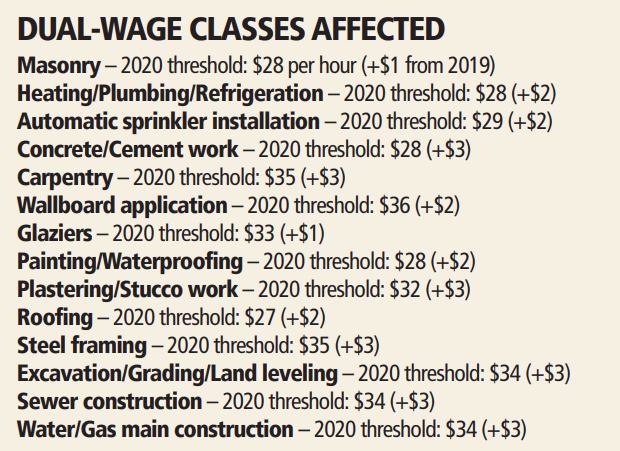Workers’ Comp – New Experience Rating, Physical Audit Levels Set

Starting in 2020, the threshold for California employers to be eligible for experience rating (X-Mod) has been reduced by order of the state insurance commissioner.
Commissioner Ricardo Lara in September approved the recommendations by the Workers’ Compensation Insurance Rating Bureau to lower thresholds for determining eligibility for experience rating and when a carrier needs to perform a physical audit of an employer’s payroll records.
NEW THRESHOLDS
Annual physical audit
As of Jan. 1, 2020: Any employer with $10,500 or more in annual premium.
Current threshold: $13,000 or more in annual premium.
Threshold for experience rating (to have an X-Mod)
As of Jan. 1, 2020: $9,700 in annual premium.
Current threshold: $10,000 or more in annual premium.
“Physical audit” is defined as an “audit of payroll, whether conducted at the policyholder’s location or at a Remote site, that is based upon an auditor’s examination of the policyholder’s books of accounts and original payroll records (in either electronic or hard copy form), as necessary to determine and verify the exposure amounts by classification.”
The eligibility rating threshold is the amount of payroll developed during the experience period in each classification, multiplied by the expected loss rates for each class. If the total for all assigned classes is at or above the threshold, then the employer is eligible for an X-Mod.
Changes to dual-wage class codes
Lara also approved the Rating Bureau’s recommendations for changes to a number of construction dual-wage class codes. While most workers’ comp classes have one rate, in some classes the difference in claims costs between high- and lowerwage workers is so great that a dual-wage classification is needed. In those cases, the workers above the threshold rate are assigned one rate, while those below that threshold are assigned a higher rate. The new thresholds are for 14 construction classifications, and any workers above the threshold will have a lower rate applied.

New State Law Alters Employment Landscape

Governor Gavin Newsom has signed a bill into law that will codify a court ruling from last year that set new ground rules for what constitutes an independent contractor, and which expands on that ruling.
There’s been a lot written in the media about the law, AB 5, and much of it misses the point. Some news reports have said it will spell the end of independent contractors in the state and that anyone a company hires to do a temporary job on contract must be treated as an employee.
Now that AB 5 is the law, state and federal labor laws will apply to independent contractors who have to be reclassified as employees. That means they would be afforded all of the associated worker protections, from overtime pay and minimum wages to the right to unionize. Employers would have to cover them under their workers’ comp policies, and extend benefits to them as they do to other employees. The law also gives the state and cities the right to sue employers over misclassification.
AB 5 codifies and expands on a 2018 California Supreme Court decision that adopted a strict, three-part standard for determining whether workers should be treated as employees. Known as the “ABC test,” the standard requires firms to prove that people working for them as independent contractors meet certain standards:
THE ABC TEST
A) Must be free from the company’s control when they’re on the job;
B) Must be doing work that falls outside the company’s normal business; and
C) Must be operating an independent business or trade beyond the job for which they were hired.
The first prong aligns with the common-law test for employment and evaluates the degree of control exercised by the company over the worker.
The second prong examines whether the worker can reasonably be viewed as working in the hiring company’s business.
The third prong inquires whether the worker independently made the decision to go into business. The fact that the hiring company does not prohibit the worker’s engagement in such an independent business is not sufficient.
Occupations exempted include:
• Doctors
• Some licensed professionals (lawyers, architects, engineers)
• Accountants, securities broker-dealers, investment advisors
• Real estate agents
• Direct sales (compensation must be based on actual sales)
• Builders and contractors (who work for construction firms that build major infrastructure projects and large buildings)
• Freelance writers, photographers (provided the worker contributes no more than 35 submissions to an outlet in a year)
• Hairstylists, barbers (must set their own rates and schedule)
• Estheticians, electrologists, manicurists (must be licensed)
• Tutors (must teach their own curriculum)
• AAA-affiliated tow truck drivers.
What employers should do
Legal experts recommend that employers:
• Perform a worker classification audit, and especially review all contracts with personnel.
• Determine which benefits and protections should be provided to any workers who are reclassified from independent contractor to employee (think health insurance and other benefits).
• Notify any state agencies about changes to a worker’s status.
• Discuss with legal counsel whether you should also include a worker as an employee for the purposes of payroll taxes, workers’ comp insurance, federal income tax withholding, ICA payment and withholding.
Note: Federal law remains unchanged. The IRS and National Labor Relations Board have their own independent contractor tests.
Worker’s Comp – Construction Dual-Wage Changes Ahead

The Workers’ Compensation Insurance Rating Bureau of California will recommend dual-wage threshold changes to a number of construction classifications for the 2020 workers’ compensation policy year.
The Rating Bureau will make the recommendations to the Department of Insurance during its annual rate filing in June. The recommendations would have to be approved by the state insurance commissioner.
While most workers’ compensation classes have one rate, in some classes the difference in claims costs between high- and lower-wage workers is so great that a dual-wage classification is needed. In those cases, the workers above the threshold rate are assigned one rate, while those below that threshold are assigned a higher rate. This is usually because the higher-wage workers are generally more experienced and tend to suffer fewer workplace injuries compared to those below the threshold.
There are 18 dual-wage classes, but not all of them are in line for changes. Opposite is the list of changes the Rating Bureau plans to recommend in its rate filing.

Management Issues: Most Bosses Guilty of Seven Deadly Sins – Poll

One of the key tenets of effective management and happy employees is for managers to lead by example. And it’s especially difficult for managers that do not exhibit to their subordinates the traits they expect of their workers.
A recent study by Florida State University shines the light on what employees think of their managers by focusing on how guilty they are of the time-honored seven deadly sins.
Researchers, who polled 750 mid-level employees, said workplaces are seeing increased levels of hostility due in large part to a deterioration of trust between supervisors and the people they manage. Worse yet, the poll found that employees who feel their bosses are guilty of sins have impaired work productivity and poorer health.
The employees polled were asked to describe how often they personally experienced a direct supervisor’s sins of wrath (anger), greed, sloth (laziness), pride, lust, envy and gluttony in the workplace.
The seven deadly sins are a classification of objectionable vices that have been used since early Christian times. The most common sins that were reported across genders, different industries and levels of responsibility were sloth, lust, pride and greed.
The poll found that:
• 41% of employees said their boss habitually pushes work on to others rather than doing it himself or herself (laziness);
• 33% said their boss tries to get others to stroke their ego (lust);
• 31% said their boss seeks undeserved admiration (pride);
• 27% said their boss pursues undeserved rewards (greed);
• 26% of employees said their boss frequently has trouble managing his or her anger;
• 23% of employees said their boss hoards resources that could be useful to others at work (gluttony);
• 19% said their boss regularly acts enviously toward others who experience good things.
The fallout
While this would seem to be bad in and of itself, the results of having a boss that is guilty of one or more of these sins are worse.
EFFECTS ON WORKERS
• Employees contributing less effort.
• Workers feeling overloaded by doing their supervisor’s work.
• Staff being less likely to make creative suggestions to bosses.
• Employees looking for new jobs.
• Physical and emotional problems and exhaustion among workers.
• Workers feeling anxious.
What to do
The above highlights the need for you to ensure that your
own supervisors exhibit behavior that is conducive to strong
employee productivity and maintaining a workplace that is
devoid of hostility.
The lesson from this study: lead by example. Work with
your supervisor
Changing Times – Safety Risks Soar as Job Market Tightens

One by-product of a strong economy is more employment, but the increased activity usually results in more workplace injuries.
That’s because there are more inexperienced people on worksites and when a company is busy and there is more activity, the chances of an incident occurring also increase. This is especially the case in manual labor environments from production facilities, warehousing and logistics to construction and other trades.
The September USG + U.S. Chamber of Commerce Commercial Construction Index found that 80% of contractors said that the skilled labor shortage is affecting jobsite safety and it’s the number one factor ncreasing safety risk on the jobsite. As business activity grows and the job market tightens, many companies are forced to hire more inexperienced workers who are not skilled at understanding all safety hazards.
Experienced personnel have the know-how to identify workplace hazards and understand the safety protocols for all aspects of their work. While training can help new hires, nothing beats experience. Additionally, with many businesses working hard to fulfill orders, workplaces are busier. Amidst all that hustle and bustle and people moving quickly, the speed and activity can also contribute to accidents in the workplace.
Also, aggressive scheduling may cause employers to use workers with less experience or training, and can push employees to work longer hours. If employees are working overtime, they may also be tired and fatigued, which can contribute to poor judgment and workplace incidents.
One other issue that’s affecting workplace safety and is related to the tight job market is that employers are often having to settle for workers they may not normally hire in other times. As you know, the scourge of opioid addiction has been rampant and unfortunately if someone who has an addiction is hired, they may be a serious liability for the employer. Not only that, but more states are legalizing recreational marijuana and nearly 40 states have medical marijuana laws on the books.
Here’s what’s concerning construction employers on the worker addiction front, according to the USG + U.S.
Chamber of Commerce Commercial Construction Index:
• 39% were concerned about the safety impacts of opioids.
• 27% were concerned about the safety impacts of alcohol.
• 22% were concerned about the safety impacts of cannabis.
The report showed that while nearly two-thirds of contractors had strategies in place to reduce the safety risks presented by alcohol (62%) and marijuana (61%), only half had strategies to address their top substance of concern: opioids, which is a growing issue.
What you can do
In this environment of labor shortages and high competition for workers, employers need to put a premium on safety.

Court Makes New Pay Rules for On-Call Workers

Employers with on-call workers who have to phone in to check on a scheduled shift are now required to pay them reporting pay, a California appellate court has ruled. The court held in the precedent-setting case of Ward vs. Tilly’s, Inc. that an employee scheduled for an on-call shift may be entitled to partial wages for that shift despite never physically reporting to work. The case hinged on what’s known as “reporting pay.”
DEFINITION OF ‘REPORTING PAY’
California’s Industrial Welfare Commission (IWC) has wage orders that require employers to pay workers who show up for a shift and then are told they won’t be working the scheduled shift.
Under the wage orders, an employer has to pay an employee who is required to report for work and does report, but is not put to work or works less than half their usual or scheduled day’s work. Reporting pay is a minimum of two hours’ pay and a maximum of four hours.
THE CASE
In the Ward vs. Tilly’s, Inc. case, employees were required to phone in to see if they would be working that day. The plaintiff in the case said that he was owed reporting pay because calling in to see if he was scheduled was essentially the same as showing up at work and being told he didn’t have to work that day, as per the IWC’s wage orders.
The appellate court on Feb. 4, 2019, upheld a lower court’s ruling that had sided with the plaintiff. It’s unclear whether the defendant will appeal the case to the California Supreme Court, but until that time and up to any potential decision, the ruling stands.
WHAT IT MEANS FOR EMPLOYERS
Previously, reporting pay was limited to those employees who physically reported to work. Now, any employee that has to call in to check on a scheduled shift will be due half of the wages they would have earned by working the shift they were on call for. The amount of reporting pay is based on the number of hours the employee normally works.
EXAMPLE: Justin, an on-call worker, is usually scheduled for six-hour shifts. When he called in on Wednesday, he was told he did not need to come into work that day. Based on the appellate court ruling, Justin must receive up to one-half of his scheduled shift, or three hours’ pay.
WHAT YOU CAN DO
- Conduct a cost-benefit analysis of retaining or keeping on-call status for employees.
- If you have on-call workers, update your employee handbook to reflect the new policy.
- If any of your workers were on call and were told not to work a shift after the Feb. 4 court ruling, you should pay them for the reporting pay they are owed.










